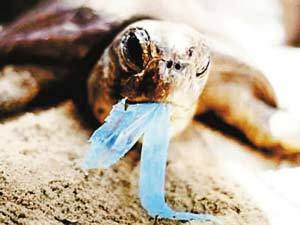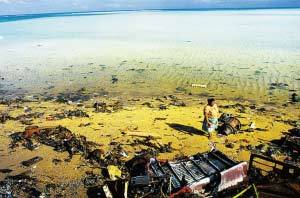According to Xinhua News Agency, within the maritime territories of the Pacific Ocean that spans from California to Hawaii, there is a vortex below the calm surface of the ocean which is formed by the circulation of ocean currents.
 |
| Diagram of "plastic vortex" |
This vortex is contributing to the accumulation of ocean waste in that area. With the movement of ocean currents, the waste left by human beings has been transformed into a giant "plastic vortex" in the Pacific Ocean.
The size of this "plastic vortex" is still expanding. In order to address this issue and protect the ocean environment, environmentalists and scientists are going to take a ship next month to visit and explore the specifics of this vortex.
Efforts being made to clean up the waste
It is estimated that 100 million tons of plastic products are produced annually around the world, including 10 percent that end up in their "final destination" of the ocean. This "vortex" of the Pacific Ocean has thus become a "waste yard" with the highest density of waste.
Reporters learned that this expedition team will set out on a round-trip excursion from San Francisco to Hawaii next month. The excursion is expected to take 50 days and will go through the "plastic vortex" twice.
This expedition team will use the "Kaisei" ship, which is about 45 meters in height and will be accompanied by a fishery ship. Researchers will use equipment on the ship to salvage waste while avoiding damage on marine lives as much as possible.
 |
|
Turtles devouring fragments of plastic bags |
The scientists estimate that the "plastic vortex" is more than 500 nautical miles (926 kilometers) off the west coast of the US, and is about twice the size of Texas.
The expedition aims to learn more about the vortex and determine if the plastic can be cleaned up.
The US and other countries and regions in Asia have been continuously dumping waste in the area during the past 60 years. Some of the waste has been slowly broken down by the sun's rays into smaller particles and have gradually formed into a "plastic vortex" under the influence of the ocean currents.
Toxic substances will enter into the human food chain
Expedition organizers say that the "plastic vortex" has been broken down into particles which are so small that most of it cannot be seen on satellite pictures, but the poisonous waste is unknowingly vacuumed up by marine life and birds, and much of it is heavy with toxic chemicals.
On May 25, the Agence France-Presse cited Doug Woodring, the environmental protection expert who is expected to lead the expedition as saying, "that means the little pieces of plastic the fish eats is actually a little toxic bomb." The more terrible thing however, is the fact that large quantities of toxic substances will gradually enter the human food chain through marine life and birds.
In the expedition, ocean scientists will also examine waste in the vortex to find out whether it can be recycled or even used to create fuel.
Although the "plastic vortex" has already been visited before, the expedition will focus its attention on scientific research.
 |
|
A large amount of waste from the ocean accumulated on the bank |
Jim Dufour, a senior engineer at the Scripps Institution of Oceanography who is responsible for the technology work on the expedition, said that on this trip they will research the impact caused by ocean surface pollutants and plastic waste on organisms, for the first time in human history.
The search for new waste disposal methods
Figures released by the United Nations Environment Program (UNEP) indicate that on average around 13,000 pieces of garbage float in every square kilometer of sea. The figure is even higher for the five major ocean currents, particularly that of the North Pacific.
Woodring said the "plastic vortex" is a mystery for scientists: "It is like going to outer space."
Dufour said that acknowledgement of the seriousness of the problem is vital for the future marine eco-environment. "Importance is an understatement, it is imperative. It will take many years to understand and fix the problem."
Dufour believes the real solution lies on land. "We need to provide the means, globally, to dispose of our waste," he said.
As the "plastic vortex" is located in international waters, the clean-up work undertaken during the expedition will not obtain support or assistance from any government. "There is no jurisdiction, no government who is entirely responsible, so there has been no push to clean it up. The world doesn't know it is out there," said Woodring.
(People's Daily Online June 1, 2009)